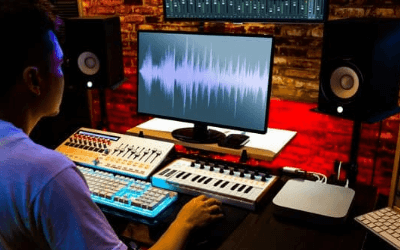Understanding editing and mixing
Revealing the art of sound:
In the field of music production, the terms “editing” and “mixing” are often used, sometimes interchangeably, but they represent different stages of the creative process. These processes are the invisible hands that shape raw audio recordings into the polished gems we hear on our favorite albums. In this blog, we take a deep dive into the world of music production, uncovering the crucial differences between editing and mixing, and highlighting their unique contributions to the musical soundscape that our ears enjoy.
Editing:
Molding the raw materials
Editing is the foundation of the entire music production process. This involves manipulating individual audio tracks to bring them from an initial, often incomplete state, to a point where they are ready for the mixing phase. This meticulous process has been likened to shaping raw marble into a work of art.
1. Timing and Arrangement:
One of the main tasks in editing is to ensure that the timing of each instrument and vocal perfectly matches the desired rhythm. Cutting, copying, and moving audio segments to create seamless, rhythmically accurate performances. This also includes designing the structure of the song, such as adding or removing sections such as verses, choruses, and bridges.
2. Pitch Correction:
Editing also includes pitch correction to help ensure all vocals and instruments are in tune. This is accomplished through tools like Auto-Tune and Melodyne, which adjust the pitch of individual notes without changing the natural timbre of the sound.
3. Compiling Tracks:
When multiple takes of vocals or instruments are recorded, editing stitches together the best parts of each take to create a single, perfect performance.
4. Noise Reduction:
Unwanted noises like clicks, pops, and background hum can ruin a perfect recording. Editing involves removing or reducing such noises to maintain audio clarity.
5. Fade-in and Fade-out:
Editing also includes adding gradual volume fades at the beginning and end of audio clips to create smooth transitions between different sections of the song.
In essence, editing is like a sculptor meticulously carving out a block of ice to reveal a masterpiece of art.
The stage is now set for the mixing engineer to work their magic.
Mixing:
The art of balancing sound
Once the audio is accurately edited, it’s handed over to a mixing engineer who acts as an audio alchemist. When mixed, raw tracks transform into a cohesive, balanced, and emotionally resonant sonic experience.
1. Balancing Audio Levels:
One of the central tasks in mixing is adjusting the volume of individual tracks to create a balanced sound. This involves deciding which elements in the mix should be more prominent or toned down to achieve the desired emotional impact.
2. Panorama and Spatialization:
Mixing engineers use panning to position each instrument or vocal within the stereo field, creating depth and dimension in the music. This spatiality creates a sense of gratification and immersion in the listening experience.
3. Equalization and Compression:
EQ and compressors are tools used by mixing engineers to shape the tonal balance of each track. This includes boosting or cutting specific frequencies to avoid sonic clashes, improving clarity, and manipulating transients to avoid peaks between samples when limiting the final mix.
4. Effects:
Mixing engineers also use various effects such as delay, reverb, and distortion to shape the sound of individual tracks in a mix.
5. Automation:
Mixing also often involves changing dynamics over time. Engineers use automation to control parameters such as volume, panning, and effects to create movement and drama within a song.
6. Reference Listening:
Professionals will use already released mainstream songs that the recording artist would like their song to be comparable to, using them as a guide to ensure certain sonic qualities are inline with the artist vision for the finished record. Sound engineer’s also high quality reference monitors and headphones to make certain that their mixes will play well on a variety of playback systems, from earbuds, to headphones, to high-end speakers.
In summary, audio mixing is a magical process. Here, individual tracks blend together into a harmonious and emotional musical experience. Mixing engineers function as both artists and technicians, creating sound quality that resonates with listeners.
Conclusion:
Editing and mixing are different phases of the music production process, but they are two sides of the same coin. Editing alters recorded tracks on the fly, removing imperfections while allowing them to remain as they were intended to be. Mixing breathes life and emotion into the song, transforming raw material into a work of art. Together, these processes represent the foundation of music production, where technical precision and creative vision come together to create songs that move, inspire, and stay with us for a lifetime.
Please be sure to check out our next educational blog… What is audio mixing?
www.rooftoprecordingstudios.com
Miami’s Premier Recording Studio






